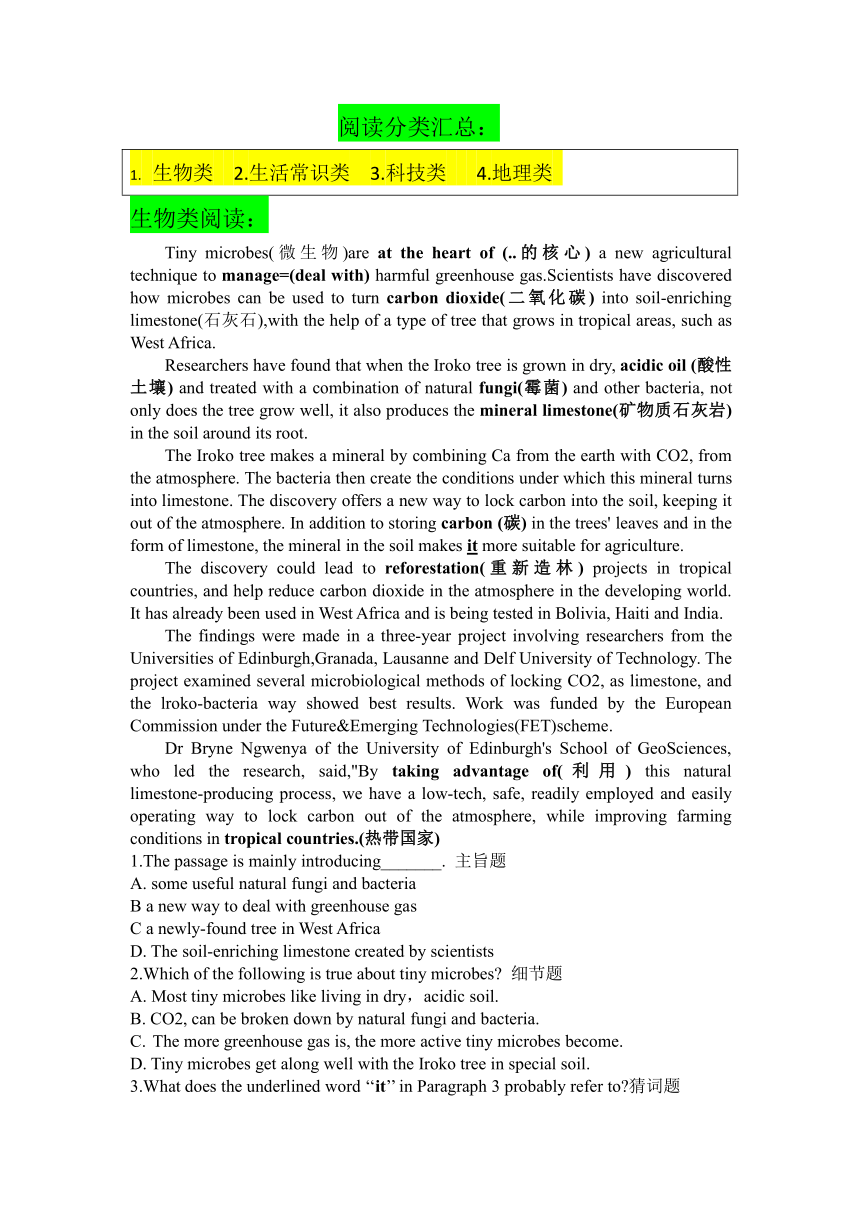
阅读分类汇总: 生物类 2.生活常识类 3.科技类 4.地理类 生物类阅读: Tiny microbes(微生物)are at the heart of (..的核心) a new agricultural technique to manage=(deal with) harmful greenhouse gas.Scientists have discovered how microbes can be used to turn carbon dioxide(二氧化碳) into soil-enriching limestone(石灰石),with the help of a type of tree that grows in tropical areas, such as West Africa. Researchers have found that when the Iroko tree is grown in dry, acidic oil (酸性土壤) and treated with a combination of natural fungi(霉菌) and other bacteria, not only does the tree grow well, it also produces the mineral limestone(矿物质石灰岩) in the soil around its root. The Iroko tree makes a mineral by combining Ca from the earth with CO2, from the atmosphere. The bacteria then create the conditions under which this mineral turns into limestone. The discovery offers a new way to lock carbon into the soil, keeping it out of the atmosphere. In addition to storing carbon (碳) in the trees' leaves and in the form of limestone, the mineral in the soil makes it more suitable for agriculture. The discovery could lead to reforestation(重新造林) projects in tropical countries, and help reduce carbon dioxide in the atmosphere in the developing world. It has already been used in West Africa and is being tested in Bolivia, Haiti and India. The findings were made in a three-year project involving researchers from the Universities of Edinburgh,Granada, Lausanne and Delf University of Technology. The project examined several microbiological methods of locking CO2, as limestone, and the lroko-bacteria way showed best results. Work was funded by the European Commission under the Future&Emerging Technologies(FET)scheme. Dr Bryne Ngwenya of the University of Edinburgh's School of GeoSciences, who led the research, said,"By taking advantage of(利用) this natural limestone-producing process, we have a low-tech, safe, readily employed and easily operating way to lock carbon out of the atmosphere, while improving farming conditions in tropical countries.(热带国家) 1.The passage is mainly introducing_____. 主旨题 A. some useful natural fungi and bacteria B a new way to deal with greenhouse gas C a newly-found tree in West Africa D. The soil-enriching limestone created by scientists 2.Which of the following is true about tiny microbes 细节题 A. Most tiny microbes like living in dry,acidic soil. B. CO2, can be broken down by natural fungi and bacteria. The more greenhouse gas is, the more active tiny microbes become. D. Tiny microbes get along well with the Iroko tree in special soil. 3.What does the underlined word ‘‘it’’ in Paragraph 3 probably refer to 猜词题 A Carbon B Carbon C Soil D Limestone 4.According to the passage, what can we infer 推断题 A. The action of the tiny microbes can increase the oxygen in the earth. B.Researchers have done the experiment on trees in Africa for three years. C.Researchers tend to use natural power to solve their problem. D.West Afri ... ...
~~ 您好,已阅读到文档的结尾了 ~~

